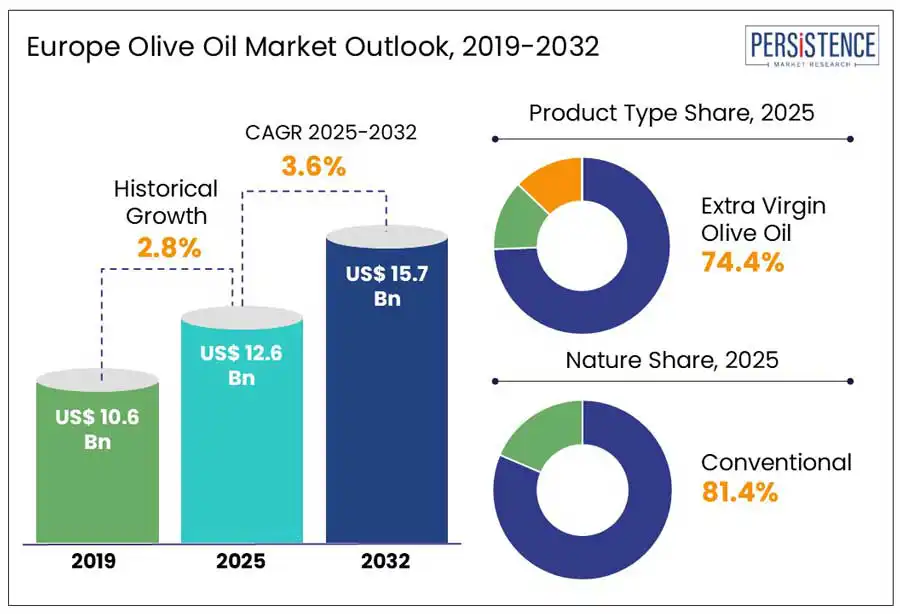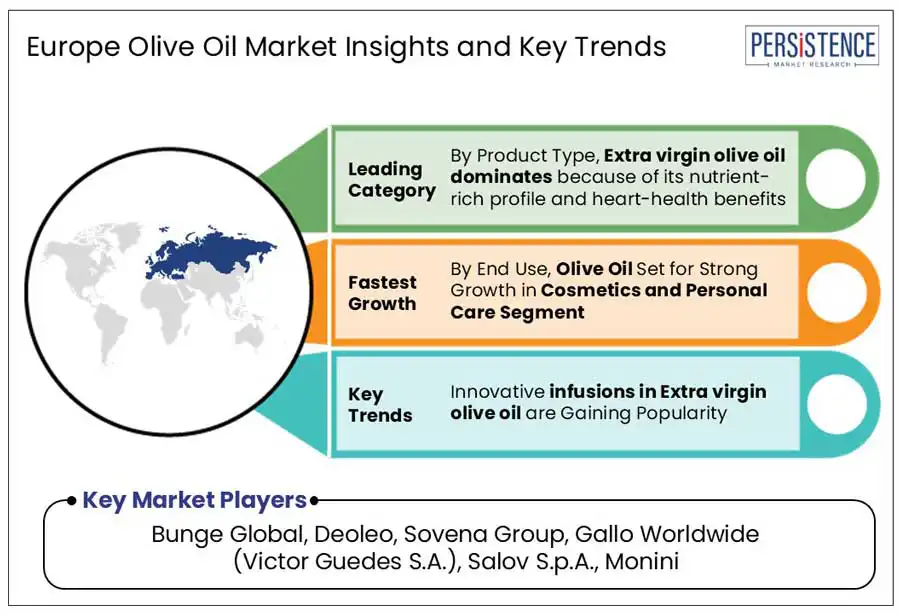Comprehensive Snapshot of Southeast Asia Lab Automation Market Including Country and Regional Analysis in Brief.
Industry: Consumer Goods
Published Date: April-2025
Format: PPT*, PDF, EXCEL
Delivery Timelines: Contact Sales
Number of Pages: 140
Report ID: PMRREP35228
The Europe olive oil Market is estimated to grow from US$12.6 billion in 2025 to US$15.7 billion by 2032. The market is projected to record a CAGR of 3.6% during the forecast period from 2025 to 2032 owing to mature demand dynamics, with historical consumption patterns and strong regional production.
Leading markets such as Spain, Italy, Greece, and Portugal continue to anchor supply, supported by established agricultural infrastructure and a reputation for quality. Evolving consumer preferences toward health-conscious and organic products drive incremental demand for premium olive oil categories.
The widespread adoption of the Mediterranean diet further reinforces consumption trends. The region faces operational headwinds from climate variability and rising production costs, impacting yield consistency. In response, producers prioritize sustainability and technological innovation to safeguard output and ensure long-term competitiveness.
Simultaneously, intra-regional trade is expanding, fueled by heightened interest in Eastern and Northern European markets. With stable demand, ongoing product premiumization, and strategic shifts in production models, the European olive oil industry remains well-positioned for sustainable growth and value-chain enhancement across the forecast horizon.

Key Industry Highlights:
|
Market Attribute |
Key Insights |
|
Europe Olive Oil Market Size (2025E) |
US$ 12.6 Bn |
|
Market Value Forecast (2032F) |
US$ 15.7 Bn |
|
Projected Growth (CAGR 2025 to 2032) |
2.8% |
|
Historical Market Growth (CAGR 2019 to 2024) |
3.6% |
Health awareness is changing consumer preferences, with olive oil turning to a leader among heart-healthy edible oils. Olive oil is known for its monounsaturated fats, antioxidants, and anti-inflammatory effects, are becoming more popular in everyday diets. This shift is further reinforced by the widespread medical endorsements and public health campaigns promoting the Mediterranean diet recognized for supporting cardiovascular health and weight management. As lifestyle-related diseases such as obesity, hypertension, and heart disease become more prevalent, health-conscious consumers across Europe and beyond are replacing saturated fats with healthier alternatives such as extra virgin olive oil. This growing trend influences household consumption and expands into restaurants and food service sectors, driving robust growth in the Europe olive oil market.
Volatile raw material costs are emerging as a significant restraint on the expansion of the European olive oil market. Olive oil production is highly dependent on olive harvests, which are vulnerable to climate variability, including droughts, frosts, and erratic weather conditions. Key nations such as Spain, Italy, and Greece have faced severe production challenges due to these climate extremes, leading to reduced yields and supply instability. Additionally, geopolitical tensions and supply chain disruptions further complicate sourcing and logistics, escalating production costs. This volatility trickles down to consumers who are price-sensitive and switch to lower-priced edible oil alternatives. According to the Netherlands Ministry of Foreign Affairs (CBI), in January 2024, all EU countries experienced a sharp rise in olive oil inflation: Portugal (+69%), Greece (+67%), and Spain (+63%), underscoring the growing economic pressure on both consumers and market stakeholders.
The Europe olive oil market holds a strong potential through eco-friendly and aesthetic packaging solutions, appealing to an increasingly sustainability-conscious consumer base. Consumers prefer packaging made from recyclable, biodegradable, or reusable materials as environmental concerns rise. For example, Gaea, a Greek olive oil brand, uses glass bottles with eco-friendly labels and minimalistic designs that emphasize purity and sustainability. Such packaging enhances visual appeal and reinforces the brand's environmental commitment. By combining green materials with attractive design, companies can boost shelf presence, align with global sustainability trends, and build loyalty among health- and eco-conscious consumers.
Extra virgin olive oil (EVOO) continue to dominate the European market due to its exceptional nutritional value and well-established heart-health benefits. Rich in monounsaturated fats, antioxidants, and anti-inflammatory compounds, EVOO is widely regarded as one of the healthiest edible oils. Its regular consumption has been linked to a reduced risk of cardiovascular diseases, making it especially appealing to Europe’s increasingly health-conscious population. As lifestyle-related illnesses such as obesity, hypertension, and heart disease become more prevalent, consumers are actively seeking natural, functional foods such as EVOO to support their well-being. Extra virgin olive oil (EVOO) is a vital component of the Mediterranean diet, highly regarded by health experts and supported by public institutions. Its market appeal is bolstered by European Union certifications such as PDO and PGI, which ensure authenticity and traceability. These factors collectively contribute to EVOO’s reputation as both a premium and health-forward choice across European households and restaurants.
Olive oil is expected to rise rapidly in the cosmetics and personal care market owing to its natural composition, skin-nourishing benefits, and rising consumer preference for clean-label beauty products. Olive oil is rich in vitamins A, D, E, and K, antioxidants, and essential fatty acids. It provides deep hydration, offers anti-aging benefits with skin-soothing effects, making it a popular ingredient in moisturizers, cleansers, soaps, and hair care products.
With the rise in awareness of chemical-free formulations, companies leverage olive oil's natural appeal to create luxury personal care products. Albogroup, a well-known Italian maker of high-quality cosmetic and toiletry products for hotels across the world, is one such example. Their Olive Collection features exquisite mini-size formats, and eco-friendly dispensers contain olive oil-based formulas to enhance the stay experience of guests.

Spain continues to lead both global and Europe olive oil production, accounting for more than 40% of the global supply on average, establishing its position as a leading player in the international market. Spain is a major producer and a key importer of Extra Virgin Olive Oil (EVOO) from developing countries. The Spanish olive oil business is heading toward quality, traceability, and sustainability, driven by rising customer demand for premium and nutrient-rich oils. To improve its global image and promote exports, Spain's Ministry of Agriculture has established strategic efforts such as the "Foods of Spain" awards for Best Extra Virgin Olive Oils and the "Spain Food Nation" campaign.
The Italian Olive Oil market is expected to grow at a CAGR of 4.6% during the forecast period. One of the most popular trends is the growing demand for family-run, artisanal olive oils, which are made in small quantities and focus on quality, tradition, and traceability. These premium oils, frequently cold-pressed and harvested by hand, appeal to health-conscious consumers seeking genuine products with rich flavor profiles and nutritional value. The Mediterranean diet, deeply rooted in Italian culinary culture, continues to play a pivotal role in driving olive oil consumption. Best known for its heart-health benefits and nutrient-rich profile, this diet places olive oil at its core, encouraging its daily use in both home cooking and gourmet applications. As Italians prioritize wellness and provenance, the Italian olive oil market is responding with innovation in packaging, storytelling, and direct-to-consumer models, all while preserving its centuries-old artisanal traditions.
The Europe olive oil market is highly competitive, fueled by innovation, premiumization, and rising demand for clean-label products. Key players are focusing on organic, cold-pressed, and extra virgin olive oils, while emerging brands promote artisanal offerings. Strategic mergers, R&D investments, and collaborations are becoming critical for expanding product portfolios and market reach. The market also benefits from powerful export markets, with organizations such as the International Olive Council (IOC) promoting global trade and quality standards. Government initiatives such as the European Union’s funding for olive oil research and quality certifications further bolster the industry’s growth, positioning it well in both mature and emerging markets.
|
Report Attribute |
Details |
|
Historical Data/Actuals |
2019 - 2024 |
|
Forecast Period |
2025 - 2032 |
|
Market Analysis Units |
Value: US$ Bn, Volume: As applicable |
|
Countries Coverage |
|
|
Segmental Coverage |
|
|
Competitive Analysis |
|
|
Report Highlights |
|
|
Customization and Pricing |
Available upon request |
By Product Type
By Nature
By End-use
By Distribution Channel
By Country
To know more about delivery timeline for this report Contact Sales

The Europe olive Oil market is projected to be valued at US$ 12.6 Bn in 2025.
Rising Consumer Shift Toward Heart-Healthy Edible Oils Is Driving Europe Olive Oil Market.
The Europe Olive Oil market is expected to witness a CAGR of 3.6% between 2025 and 2032.
Companies can introduce eco-friendly and aesthetically appealing packaging solutions to attract sustainability-conscious consumers, which presents a key market opportunity.
Key players in the Europe olive Oil market include Bunge Global, Deoleo, Sovena Group, Gallo Worldwide (Victor Guedes S.A.), Salov S.p.A., Monini, and others.